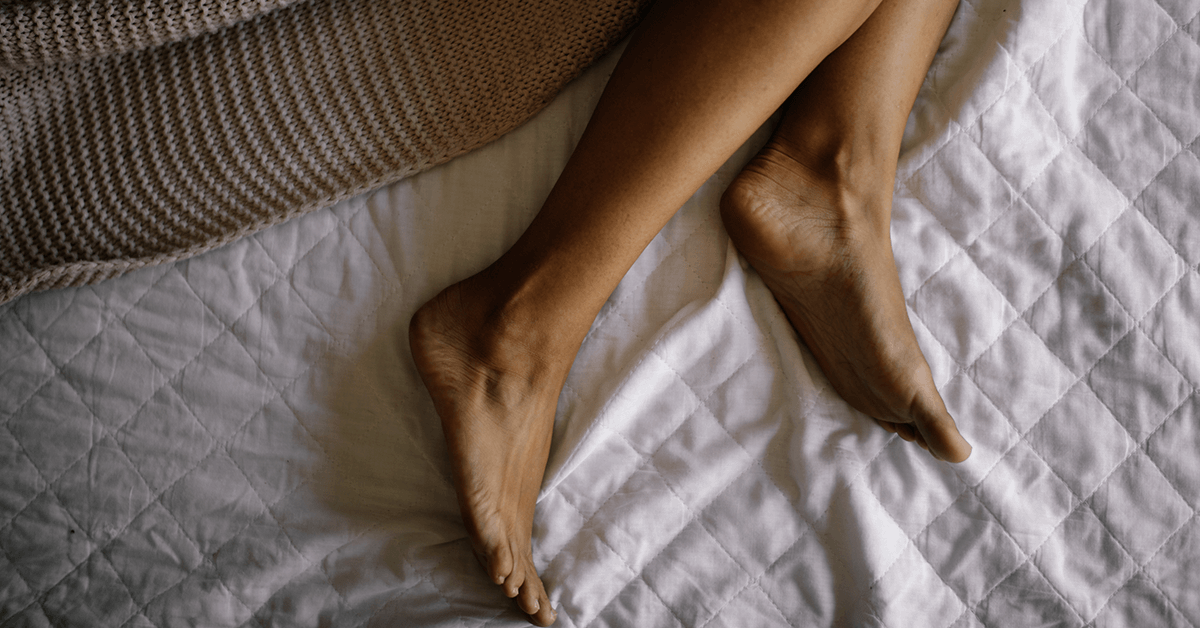Use the player to listen to the article and/or continue to read below.
The Cause | Are You At Risk | Symptoms | The Diagnosis | Treatments | Medications
Introduction
Restless Legs Syndrome (RLS), aka Willis-Ekbom Disease, aka RLS/WED, arises from neurological dysfunction and is a common sleep disorder. It’s a condition wherein the patient experiences an uncontrollable stimulus/urge to move their legs, due to an uncomfortable tingle or feeling.
The urge usually arises during the evening or night hours, when the body is still or is trying to sleep. The movement of the legs eases the uncomfortable tingle temporarily.[1] The disease can manifest at any age and in any gender, though middle-aged women are at the highest risk of RLS. In general, RLS is chronic and has no permanent treatment.
Lifestyle changes help more for alleviating symptoms than medication. The biggest concern for patients suffering from RLS is that they start showing signs of excessive daytime sleepiness, or hypersomnia, because of their nocturnal restlessness. Depression is a secondary symptom of hypersomnia and RLS.
The Cause
The root cause of RLS is not yet completely known; however, experts believe that it is either genetic or due to environmental factors, or a mix of both. Both of these factors cause a neurological imbalance in the brain that involves dopamine, which is responsible for sending messages to control muscle movement.
Restless Legs Syndrome is sometimes seen in patients who are prescribed antidepressants for extended periods of time.[2]
Are you at Risk?
A family history of RLS, hypersomnia, depression, Parkinson’s or Alzheimer’s, low iron levels in the brain,[3] being of Northern European descent,or having diabetes can put one at a higher risk of developing Restless Legs Syndrome.[4]
Symptoms
While the patient’s primary symptom may be moving their legs while lying still, accompanying symptoms can aid in the diagnosis of RLS. If one experiences any of the following, one must consult a doctor:
- Comfort upon movement of legs
- Aggravation of symptoms during nighttime
- The sensation of movement occurs in the limb rather than on the skin
- Leg twitching at night
- A sensation of crawling, creeping, pulling, throbbing, aching, itching, or electrification within the legs repeatedly, while in a state of rest
Diagnosis
RLS is usually diagnosed based on symptoms. One must know that there is no definitive test to date that can diagnose RLS. Some blood or neurological tests can be used to diagnose the condition but these tests are not entirely conclusive.
It’s suggested that patients document their symptoms as precisely as possible before their consultation with a doctor. The most crucial indicator in diagnosis remains the same: an unstoppable urge to move the legs that ease with movements. RLS may affect the arms as well.
Treatments
The treatment in Primary RLS—RLS that is not related to other medical conditions or medications is usually treated with medications and lifestyle changes.
The treatment in Secondary RLS—RLS that is related to another disease or medication—is usually done by first treating conditions that may be causing or making RLS worse. Alternately, medications that are known to cause or exacerbate RLS should be ceased, for example, Prozac, Zoloft, and Paxil, which are used to treat anxiety and depression.
Lifestyle Changes
- Exercise, 3 to 5 days a week, 25-40 minutes in each session
- Eat a well-balanced nutritional meal that includes minerals, vitamins, protein, carbohydrates, and fiber: fruits, salads, nuts, beans, and green leafy vegetables
- Avoid alcohol and caffeine before bedtime
- Support therapies, like meditation, breathing exercises, and yoga
Medication
Medications can provide relief for serious RLS symptoms. Rest assured, your sleep doctor will adjust your drug and dosage to help you manage symptoms. Commonly prescribed drugs include:
1. Dopamine agonist drugs like Pramipexole, Ropironole or Rotigotine
2. Certain anticonvulsant drugs, like Gabapentin or Pregabalin
3. Opioids/Narcotics, such as Tramadol, Codeine, Oxycodone, or Methadone are only for severe cases of RLS
4. Benzodiazepines, like Clonazepam, have been found to be useful in certain cases
Common Home Remedies
Conservative home remedies are often used to help manage the symptoms of RLS,[5] including:
- Following a strict and regular bedtime schedule: reading a book before going to sleep or listening to relaxing music
- Sleeping and waking at the same time
- Massaging the legs with lukewarm essential oils before bedtime
- Enjoying hot baths before bedtime
- Placing vibrating pads on legs while sleeping
Conclusion
If you’re experiencing symptoms of RLS, you’re not alone. Make an appointment to see your primary care doctor to talk about possible treatment plans.
References:
- Office of Communications and Public Liaison, N. (2020, March 17). Restless Legs Syndrome Fact Sheet. Retrieved from https://www.ninds.nih.gov/: https://www.ninds.nih.gov/Disorders/Patient-Caregiver-Education/Fact-Sheets/Restless-Legs-Syndrome-Fact-Sheet
- Kolla, B. P., Mansukhani, M. P., & Bostwick, J. M. (2018). The influence of antidepressants on restless legs syndrome and periodic limb movements: A systematic review. Sleep medicine reviews, 38, 131–140. https://doi.org/10.1016/j.smrv.2017.06.002
- Erica R. Sun, C. A. (1998, June 1). Iron and The Restless Legs Syndrome. Retrieved from https://academic.oup.com/: https://academic.oup.com/sleep/article/21/4/381/2731968
- Mirghani H. (2020). Restless Legs Syndrome Among Sudanese Patients With Type 2 Diabetes Mellitus: A Case-Control Study. Cureus, 12(8), e9635. https://doi.org/10.7759/cureus.9635
- Allen, R. P., Bharmal, M., & Calloway, M. (2011). Prevalence and disease burden of primary restless legs syndrome: results of a general population survey in the United States. Movement disorders : official journal of the Movement Disorder Society, 26(1), 114–120. https://doi.org/10.1002/mds.23430






